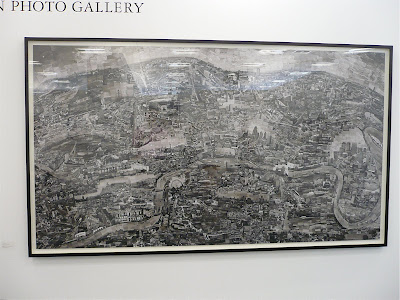
It can't have escaped those of you who follow the photography scene that there's a lot going on in the"camera-less" photography world. Adam Fuss at Cheim and Read, Christopher Bucklow at my gallery with Garry Fabian Miller coming up next, and the major exhibition "Shadow Catchers" which just opened at The Victoria and Albert Museum in London.
One of the lesser known artists in the V&A show, but equally worthy of attention, is the German photographer Floris Neusüss. Neusüss was one of the first contemporary artists to return to camera-less photography, one of the medium’s earliest forms. In 1978, Neusüss created a piece that paid specific homage to William Henry Fox Talbot's 1835 image of a window in Lacock Abbey and last year he re-created the piece specifically for the V&A show.
As curator Martin Barnes explains: “Talbot’s Latticed Window anticipated the notion that photographs are often perceived as windows on the world. And yet, Talbot seems to have understood that it was rather the window itself – half way between interior and exterior – that was as beguiling as any view beyond.”
“This particular subject”, adds Neusüss “was, for us, not just a window in a building but an iconic window, a window on photography. Lacock’s discovery became a window on the world. Back in 1978, when we first photographed the window, that was the first time I worked outside of the studio, on location. It was the start of our adventures in making photograms of large objects in the places we found them".
As you'll see from these pictures, the piece that Neusüss made is extraordinarily beautiful and resonant, innovative, and chock full of ideas - a description that applies equally to the other artists in the show, So if you're in London, be sure not to miss the exhibition.
(All photographs via the London Daily Telegraph. Unfortunately no photographer's credit was attached.)
 In collaboration with his wife Renate Heyne, also an artist, Neususs covered the interior of the window with photographic paper at night, before exposing the paper by shining a light from outside.
In collaboration with his wife Renate Heyne, also an artist, Neususs covered the interior of the window with photographic paper at night, before exposing the paper by shining a light from outside.
 Some of the test prints are laid out on the floor of the abbey.
Some of the test prints are laid out on the floor of the abbey.
 Floris Neusüss
Floris Neusüss
 The finished Neusüss piece.
The finished Neusüss piece.
 Photogenic drawing negative by William Henry Fox Talbot (1800-1877). Taken with the Camera Obscura, this photograph is the earliest camera negative in existence.
Photogenic drawing negative by William Henry Fox Talbot (1800-1877). Taken with the Camera Obscura, this photograph is the earliest camera negative in existence.
 1936. The picture that started it off.
1936. The picture that started it off.















































.jpg)



